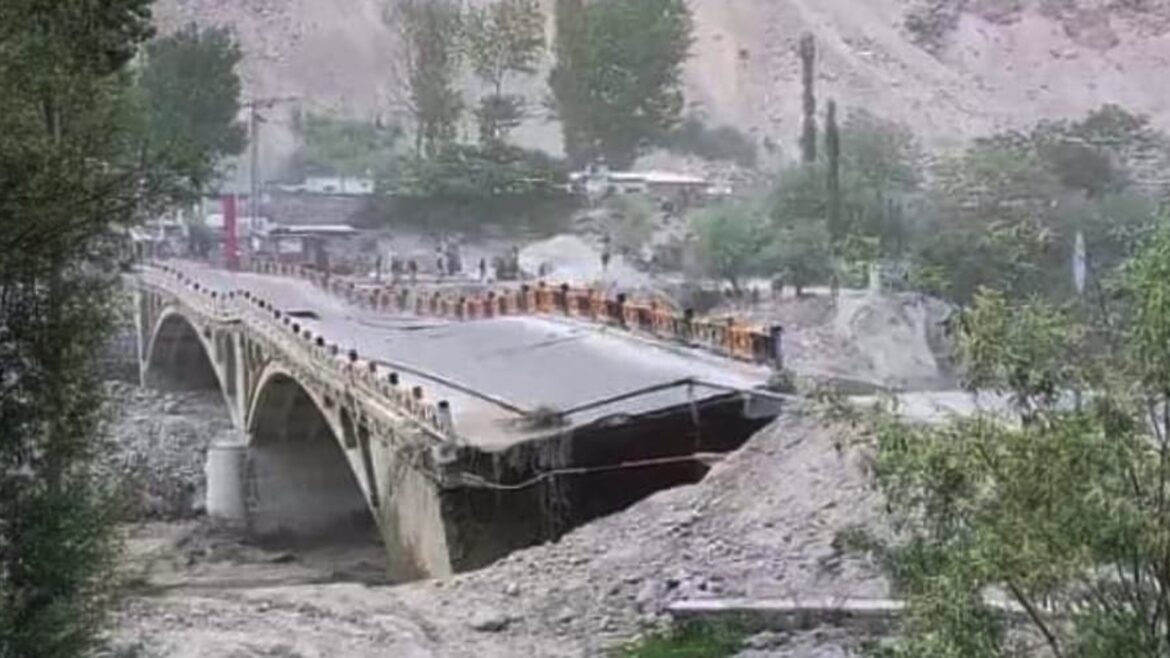The massive GLOF from Shishper Glacier was triggered because of an abrupt temperature rise in the are due to the prevailing heat wave
By Staff Reporter
ISMALABAD: A glacial lake outburst flood (GLOF) swept away a major bridge on the Karakoram Highway in the Hassanabad village of Hunza valley on Saturday, disconnecting Gilgit and Hunza from the rest of the country.
A massive GLOF occurred in Hassanabad village after the lake formed over the Shisper Glacier started discharging over 5,000 cusecs water on premature melting as high temperature in the area, officials said.
Sher Mohammad, remote sensing specialist at the International Centre for Integrated Mountain Development, said the glacial lake size was 15 percent more than the recorded size for the past three years at the pre-outburst level of the lake.
“The massive GLOF in Hunza from Shishper Glacier was mainly triggered because of an abrupt temperature rise in the Northern Areas due to the prevailing heatwave phenomenon,” Mohammad said.
Glaciers were melting at a faster pace mainly due to heatwave and Shisper Glacier lake area had increased 40 percent in the past 20 days due to expedited melting after heatwave impacts gripped the Northern Areas. Mostly, glacial lakes are formed in May but it got developed one month ahead in April.
Mohammad said the Karakoram Highway Bridge was partially damaged due to the massive flooding that disconnected Gilgit and Hunza.
Research in the area revealed that lakes on, at least, five glaciers appeared prematurely in the month of April and some of them have erupted where the water was running faster than usual.
“We have been able to record only five glacial lakes due to continuous clouds, which are increasing but the number could be much higher,” Mohammad said.
Experts said there were supra-glacial lakes formed over vulnerable glaciers after rapid increase in temperatures and could become a lurking threat in the coming days as more increase in temperature would drive glacial flooding further.
Satellite reports and images of the five glacier lakes indicate that other glaciers in the area could also pose a threat to the lakes. “This is not usually the case in April and glaciers and lakes are recorded in the month of June or later, but temperatures above five degrees Celsius can cause a number of natural disasters,” they warned.
Disaster management authorities in Gilgit-Baltistan and Khyber Pakhtunhwa had relocated the local people from the vulnerable sites to safer places and were not facing any threat due to GLOF.
The Shisper Glacier had started surging in 2018 and breached thrice from 2019 to 2020.
Meanwhile, Minister for Foreign Affairs Bilawal Bhutto Zardari said that rapid melting of glaciers in Gilgit-Baltistan is a matter of concern.
In his statement on the flood situation in Gilgit, he said that the situation created by the eruption of the lake on the Shisper Glacier needs to be dealt with on an urgent basis to ensure that no harm is done to the local population and the land routes remain open.
Copyright © 2021 Independent Pakistan | All rights reserved




